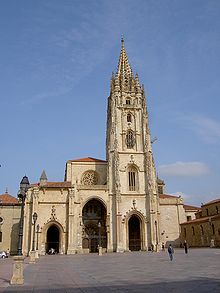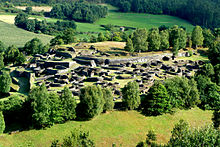History of Asturias
There are rock paintings that date back 30,000 years and correspond to the Solutrean, Magdalenian, and Aurignacian cultures of the Upper Paleolithic and typical of both the peoples of the Cantabrian Mountains and Southern France.
[1] Evidence of the Asturian Neolithic includes the thirty dolmens of the prehistoric necropolis of Mount Areo, between Carreño and Gijón, 5,000 years old, as well as burial mounds and the Idol of Peña Tú (Llanes).
Had it not been for the treachery of Brigaecium city, which alerted the Romans thus giving them time to reorganize and repel the attack, the Asturians would have overwhelmed the troops of General Publius Carisius.
[13] Military control allowed for a reliable extraction of precious minerals, especially in El Bierzo through the mines of Las Médulas, located in present-day León.
Pelagius managed to escape from Córdoba in 717, reaching the Piloña River in 718, and that same year, he became the leader of the Astures, after persuading and convincing the Asturian people of the need to unite their forces against "the common enemy."
This castro, which in the times of Augustus protected the nearby city of Lucus Asturum (probably in the Lugones area), was located on the top of Obetao hill.
[16] In the early days of the institution, the territory of Asturias belonged to the prince as his patrimony, and he could appoint judges, mayors, among other people to govern on his behalf.
On May 9, the General Junta of the Principality of Asturias chose to disobey the orders coming from Madrid, where the executions of May 2 had taken place, causing tension among the Asturians and serving as the reason for disobedience.
Originated mainly in the mid-19th century,[40] it experienced its golden age after 1914 due to Spain's neutrality in the Great War and the protectionism of successive governments.
[43] It wasn't until 1901 that a large-scale strike occurred, with workers from El Musel port and supported by those from the Moreda factory, but it was thwarted by pressure from the employers.
[44] To counter it, the Patronal Association of Asturian Miners, promoted by the anti-worker Marquis of Comillas, proposed Catholic trade unions, which were not very popular.
[44] During Primo de Rivera's dictatorship, unionism, especially SOMA, adopted a lower profile and toned down its struggle, resulting in a precarious situation for the mining population.
[44] The Asturian Revolution of 1934 was a workers' uprising part of the "revolutionary strike" and armed movement organized throughout Spain known as the October Revolution of 1934, which only took root in Asturias,[45] mainly because the CNT integrated into the Workers' Alliance proposed by the socialists of UGT (Unión General de Trabajadores) and PSOE (Partido Socialista Obrero Español), unlike the rest of Spain.
The military operations were directed by General Franco from Madrid and involved the use of Moroccan colonial troops (the regulares of the Army of Africa) and the Legion from Spanish Morocco.
Following the left's electoral victory in February 1936, many of the prisoners from the uprising were granted amnesty, but in July 1936, several military commanders rose up against the democratically elected government.
The conflict lasted fifteen months, during which the main battles were fought around the capital, besieged by the militia, and on the borders of the region, Eo, Deva, and the Cantabrian coast, where the offensives of the national army tried to break the siege of the city.
After the coup, the Republican forces did not manage to dominate the entire province, despite being a majority, due to Colonel Aranda's support to the rebels, the head of the army in Oviedo.
Colonel Aranda delayed his decision to support the uprising until July 19, taking enough time to make the Republican authorities believe his loyalty to the regime and to gather the bulk of the military forces and Civil Guard in Oviedo for its defense.
[51] Both sides set their objectives: the Republican government aimed to quickly eliminate the rebel strongholds, while the Nationalists attempted to resist until the arrival of reinforcements from Galicia, known as the Galician column.
[50] The rebels in the barracks of Gijón were defeated after 33 days of siege, despite the support provided by the cruiser Almirante Cervera, which bombarded the city from the coast.
[51] On the other hand, Oviedo was cut off and remained so until October 17, when Galician troops led by Colonel Tejeiro penetrated the city through a passageway opened from Grado through the Escamplero.
The arrival of the Galician column to Oviedo sparked a crisis between anarchists and communists, leading to changes in some councilors and a shift in focus towards prioritizing military victory over social revolution.
Meanwhile, Oviedo received more aid through the opened passageway, improving the harsh living conditions of the besieged and increasing the number of prisoners and those subjected to repression, which had been relatively low in the early months.
Demoralization in the days before the fall of Gijón was total, with many prominent leaders fleeing from El Musel, leading to numerous desertions and a sense of "every man for himself."
Naval vessels, merchant ships, and even fishing boats were used to evacuate soldiers and civilians (some managed to escape the Nationalist blockade, while others were captured, and one, the destroyer Ciscar, was sunk in the harbor).
In 1957, Francisco Franco inaugurated the first blast furnace of ENSIDESA, a steel company owned by the INI (Instituto Nacional de Industria).
[59] In 1976, opened the "Y Griega", the first Asturian carriageway, connecting Avilés, Oviedo, and Gijón through a system of three branches joined in a road junction in Serín.
The industrial reconversion, which took place approximately between 1986 and 1995 as part of the government's plans to align with the European Union, resulted in staggering unemployment figures in Asturian cities, reaching 24% in Avilés in 1988[63] and 26% in Gijón in 1987.
With the arrival of democracy in Spain, the Regional Council of Asturias was created as a provisional pre-autonomous body, presided over by Rafael Fernández Álvarez.
From July 22, 2003, he governed with the support of IU (United Left) and in 2007 he won the elections again and, although he failed to obtain an absolute majority, he once again took office, followed by Vicente Álvarez Areces "Tini" as president.


























